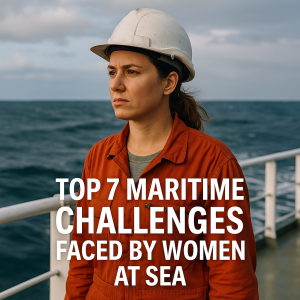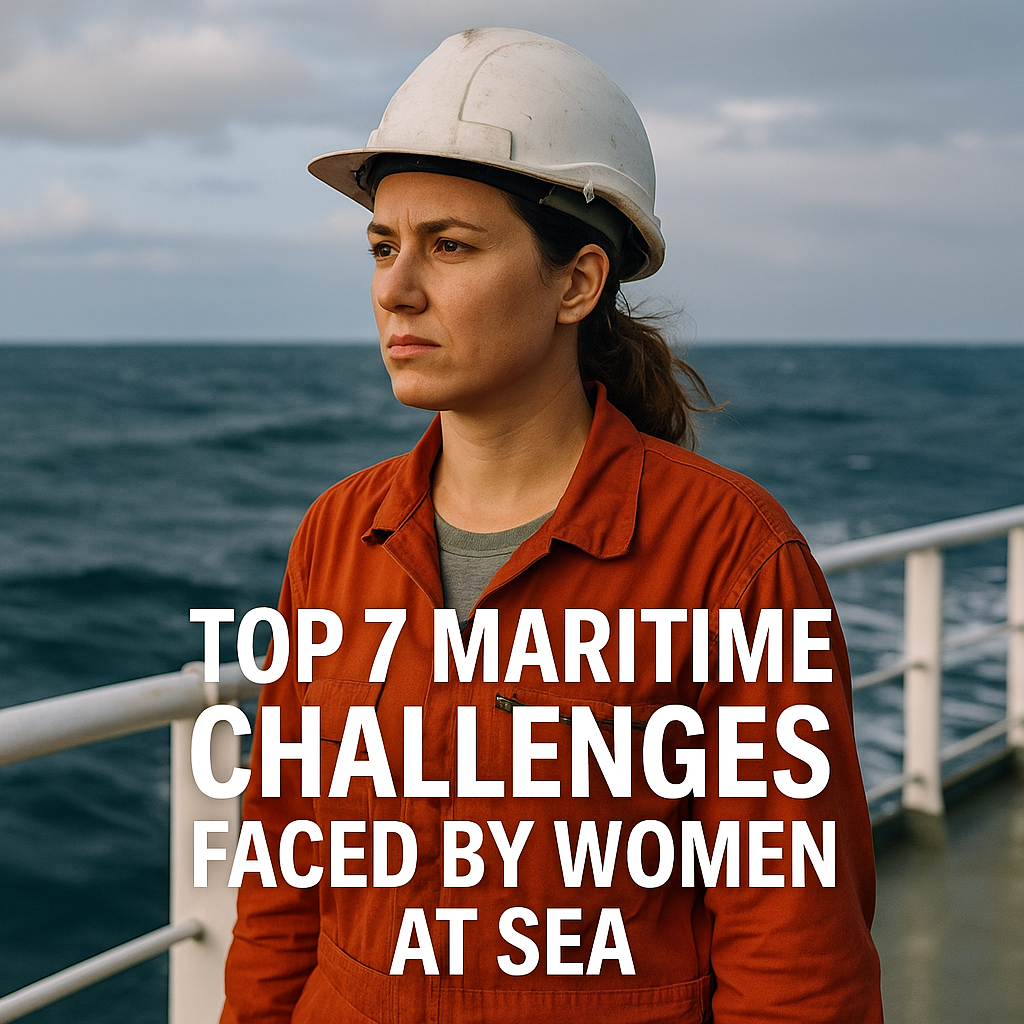
Women make up only a small share of seafarers and face distinct barriers on board. Discover the top 7 challenges for women at sea—from harassment and PPE fit to career progression—and the evidence-based fixes shipowners, schools, and crews can deploy now.
“Same ocean, different storm”
Picture two cadets walking up the gangway on the same day—equal in certification, grit, and ambition. Weeks later, their realities can look very different. One settles into a crew that welcomes her as a professional. The other navigates a maze of subtle exclusions, ill-fitting safety gear, bathroom improvisations, and a culture that jokes away what should never be joked about.
Women have always gone to sea—quietly, brilliantly, and often invisibly. Yet the numbers still show how far we have to go. Women account for about 1.2% of the global seafarer workforce, even after a notable increase since 2015. The IMO’s International Day for Women in Maritime (18 May) keeps the issue on the agenda, stressing that seafaring remains male-dominated and that real inclusion requires structural change, not slogans.
This article is a practical guide for maritime students, officers, managers, and educators. We identify seven core challenges women face at sea and translate the latest guidance from IMO, ILO/MLC, ISWAN, WISTA, ICS, and national administrations into workable shipboard actions. The tone is human, the solutions are doable, and the references are current—because progress depends on detail.
Why the topic matters in modern maritime operations
Shipping moves more than 80–90% of world trade. Its safety, productivity, and social license depend on recruiting and retaining the best people—across genders, ages, and backgrounds. A crew that feels safe and valued stays longer, performs better, and reports near-misses and hazards more openly. Evidence from welfare helplines shows that abuse, bullying, harassment, and discrimination remain a concern. Creating respectful ships is not just “nice to have”; it is a core risk-management and compliance obligation under MLC 2006 and evolving IMO/ILO guidance on violence and harassment.
Finally, the sector is changing fast—new fuels, new risks, new skills. You cannot navigate a decarbonizing and digitalizing industry by excluding half the talent pool. The business case and the human case point in the same direction.
–
The top 7 maritime challenges faced by women at sea (and the practical fixes)
1) Safety from harassment, bullying, and sexual assault
Harassment can be overt (comments, propositions, threats) or covert (assignments designed to isolate, rumor-spreading, “banter” that becomes hostile). Women may self-censor, avoid the mess, or skip reporting due to fear of retaliation or disbelief. Surveys and helpline data show bullying and harassment affect a significant share of seafarers, with higher reporting among women.
Fixes: Zero-tolerance policies, multiple confidential reporting channels, victim-centered investigations, anti-retaliation clauses, and shipboard drills for harassment response.
2) Facilities and privacy: basics that still get overlooked
Shared sanitary spaces, poor locks, and ad hoc arrangements increase stress. Privacy is not a luxury; it is psychological safety.
Fixes: Gender-sensitive accommodation audits, secure locks and lighting, private sanitary facilities or schedules, and immediate correction of facility defects.
3) PPE, equipment, and ergonomics that actually fit
Oversized coveralls snag. Gloves slip. Safety harnesses don’t sit right. Ill-fitting PPE is a direct hazard and a daily reminder of exclusion.
Fixes: Stock inclusive PPE sizes (coveralls, boots, immersion suits, harnesses), update SMS matrices, and include fit-testing in familiarization.
4) Pregnancy, menstruation, and medical support at sea
Women may hide needs to avoid stigma or fear being assessed as “unfit.” Inadequate sanitary disposal or restricted supplies add health risks.
Fixes: Stock menstrual products, ensure disposal units, confidential pathways for pregnancy disclosure, and ship medical guides that include gynecological issues.
5) Isolation, micro-exclusions, and the “only one of me” effect
Being the only woman in a department (or ship) amplifies isolation. Small exclusions compound: being left out of chats, always being asked to take notes, or eating alone.
Fixes: Belonging checks by the master, fair task rotation, buddy/mentor systems with trained mentors in the fleet.
6) Career progression, training opportunities, and the glass ladder
Women can plateau at mid-level ranks due to assumptions, lack of command experience, or biased promotion practices.
Fixes: Transparent promotion criteria, mixed-gender boards, anonymized CVs, and reserved slots for under-represented groups in type-rating courses.
7) Reporting without retaliation—and remedies that actually work
Fear of career damage silences reporting. Without robust systems, harassment cases go unaddressed.
Fixes: Multi-channel reporting (internal and external), anti-retaliation audits, third-party reviews, and post-voyage checks at 30/90 days.
–
Key developments driving change
-
MLC 2006 amendments entered into force on 23 December 2024, strengthening welfare protections.
-
IMO–ILO joint actions in 2024–2025 target violence and harassment, requiring policies, training, and reporting systems.
-
The IMO–WISTA Women in Maritime Survey (2021/22) and industry diversity handbooks provide data and practical guidance.
-
ISWAN helplines reported sharp increases in abuse/bullying/harassment calls in 2023.
-
EMBARC standards in the U.S. serve as a reference model for SASH prevention.
–
Challenges and solutions: Closing the gap between paper and practice
Closing the gap between written policy and actual practice requires addressing several human and operational challenges. Policies must be consistently visible, rehearsed, and enforced to be effective. To overcome the fear of retaliation that suppresses reporting, anonymous and external reporting options are vital. For crew welfare, even small vessels can meet privacy standards with simple retrofits and procedures, while supply chains must guarantee inclusive PPE sizing to protect all crew members. Finally, addressing recruitment challenges demands active partnerships with maritime schools and the establishment of robust onboard mentoring programs to cultivate the next generation of seafarers. In short:
- Policies must be visible, rehearsed, and enforced.
- Fear of retaliation suppresses reporting—anonymous and external options are vital.
- Even small vessels can meet privacy standards with simple retrofits and procedures.
- Supply chains must guarantee inclusive PPE sizing.
- Recruitment requires active partnerships with maritime schools and mentoring programs.
Case studies
-
A tanker fleet adopted four reporting channels and harassment drills, improving reporting and retention.
-
A bulk operator integrated ISWAN helplines into pre-joining briefings, improving perceived safety.
-
Training ships that implemented EMBARC-style standards saw better coordination between academies and operators.
Future outlook: From “women in maritime” to simply “maritime”
The long-term goal is not a parallel system for women, but a maritime workforce where competence and safety are the culture. As decarbonization and digitalization reshape the industry, inclusion is both a fairness issue and a strategic necessity. Ships with inclusive cultures are safer, more resilient, and more attractive to the next generation.
Frequently asked questions (FAQ)
1) What percentage of seafarers are women today?
About 1.2% of the global seafarer workforce, with numbers slowly rising since 2015.
2) What rules protect women at sea from harassment?
The MLC 2006 framework (amendments effective from December 2024), IMO/ILO initiatives, and national standards such as EMBARC.
3) How can small vessels ensure privacy and dignity?
Through procedural fixes (usage schedules) and low-cost retrofits (locks, partitions, disposal units).
4) What should a ship do after a harassment report?
Prioritize safety, preserve evidence, start a time-bound investigation, and enforce anti-retaliation safeguards.
5) Is inclusive PPE a requirement or just best practice?
It is a requirement under MLC health and safety obligations—PPE must fit the wearer.
6) How do we measure progress?
By tracking reporting rates, retention, promotion timelines, and PPE fit issue closures.
7) Where can seafarers find confidential help?
Through ISWAN’s 24/7 helplines and company/union hotlines.
Conclusion: From compliance to confidence
The ocean will always be demanding. But exclusion is optional. Ships that give women safety, privacy, fitting gear, career pathways, and fair reporting systems create better conditions for everyone. The frameworks exist. The solutions are known. What remains is leadership—on board and ashore—to turn paper into practice.
Fair winds—and safe watches—for all. ⚓
References
-
International Maritime Organization (IMO). Women in Maritime (programme page).
-
IMO. International Day for Women in Maritime 2025.
-
IMO Press Briefing (2025). “An ocean of opportunities.”
-
BIMCO/ICS. Seafarer Workforce Report (2021).
-
IMO & ILO. Preventing and combating violence and harassment in maritime (2024).
-
ILO. MLC, 2006—Amendments entered into force 23 December 2024.
-
ILO/IMO Joint Working Group on Seafarer Issues — harassment and bullying resolutions.
-
U.S. MARAD. EMBARC Standards.
-
ISWAN. News on abuse, bullying, harassment reports (2023) & Annual Review 2023/24.
-
IMO–WISTA Women in Maritime Survey (2021).
-
WISTA International / Anglo-Eastern / ICS / ISWAN. The Diversity Handbook.
-
Global Maritime Forum. Improving seafarer wellbeing—Diversity@Sea.
-
Reuters. Sea Change: Seafarers and Decarbonisation.

